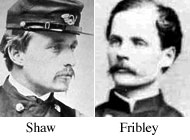In the Shadow of Robert Gould Shaw

A young officer with a promising future serves as colonel of a colored regiment and is killed leading his regiment into battle. His tragic death is mourned by his troops, who go on to further their hard-earned reputation as fighting men. This of course is the story of Robert Gould Shaw of the Fifty-fourth Massachusetts Infantry.
It is also the story of Charles Wesley Fribley of the Eighth U.S. Colored Infantry. He and Gould have much in common.
Both attended college. Boston-born Gould spent three years at Harvard and Fribley, born and raised on a farm in Lycoming County, Pennsylvania, attended Dickinson Seminary in Williamsport.
Both began their Civil War service in a three-month regiment and became line officers in other regiments before taking the helm of colored infantrymen. Gould served in the Seventh New York and Second Massachusetts and rose in rank from second lieutenant to captain. Fribley served in the Eleventh and Eighty-fourth Pennsylvania and rose in rank from sergeant to captain and adjutant.
Both became colonels in colored regiments in 1863. Gould became major of the Fifty-fourth in March and advanced to colonel in April. Fribley became colonel of the Eighth in November.
Both men died in action after being in charge of their regiments for three months. Gould suffered a mortal wound in the assault on Fort Wagner, South Carolina, in July 1863. He died at age twenty-five. Fribley suffered a mortal wound rallying his men in the Battle of Olustee, Florida, in February 1864. He died at age twenty-eight.
Both men were buried with their men on the field of battle. Those who survived went on to fight with distinction in other battles until the end of the war
Gould left behind more than 200 letters. His story, and those of the men of the Fifty-fourth, were told on the big screen in the movie Glory.
Fribley and the Eighth were memorialized in Hymn of the Freedman soon after the colonel's death. His story, and those of his men, have faded from national memory.
Photo credits: Robert Gould Shaw from the National Gallery of Art; Charles Wesley Fribley from the American Civil War Research Database.
Labels: charles wesley fribley, civil war, colonel, eighth u.s. colored infantry, fifty-fourth massachusetts, robert gould shaw, union, usct

